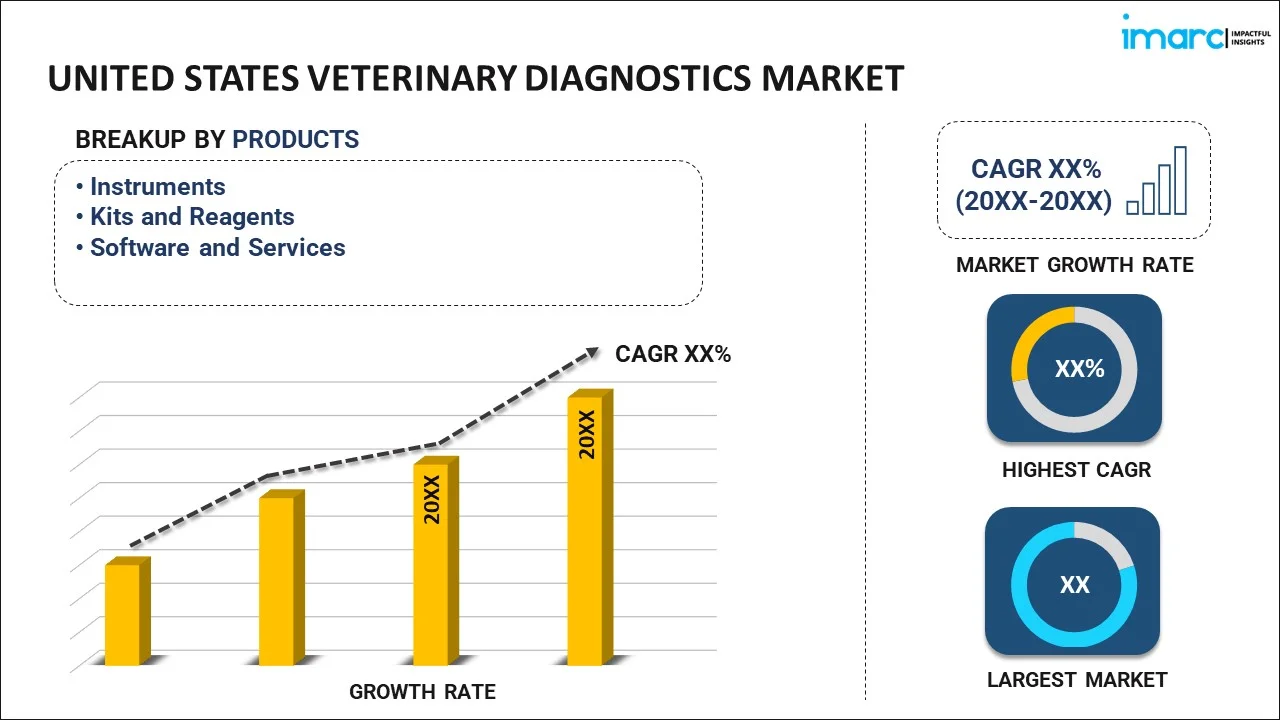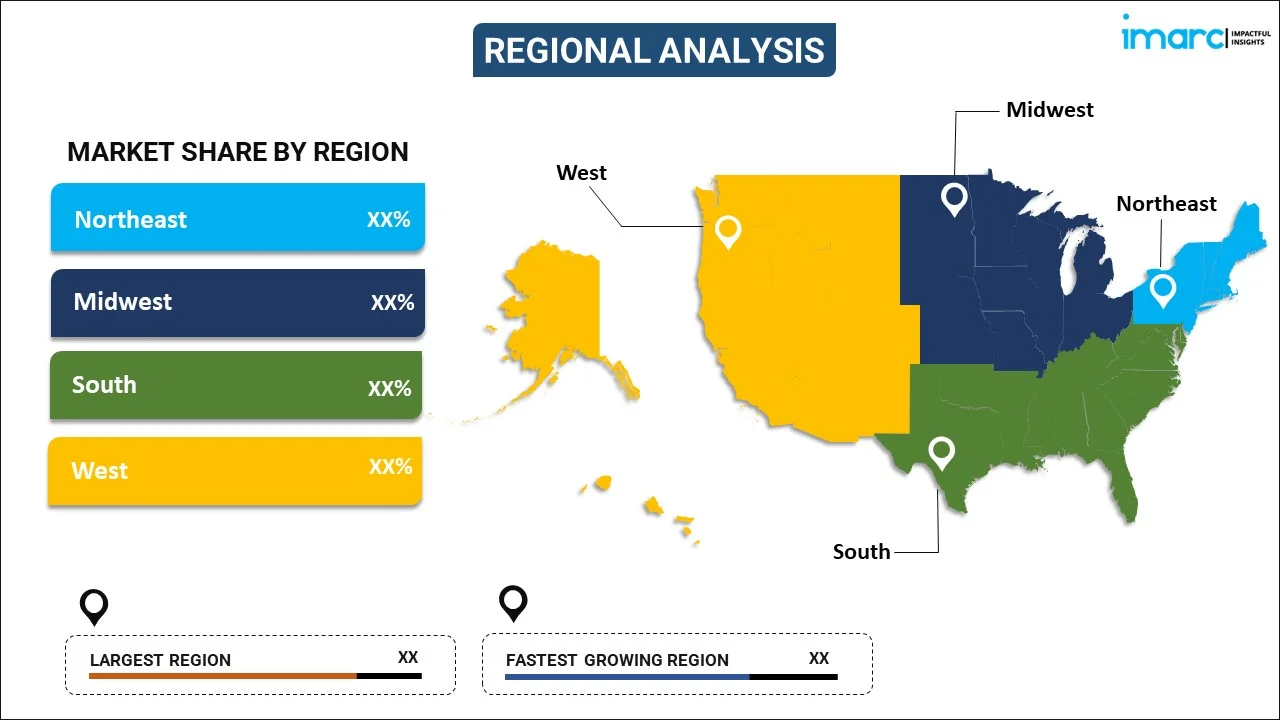
United States Veterinary Diagnostics Market Report by Product (Instruments, Kits and Reagents, Software and Services), Technology (Immunodiagnostics, Clinical Biochemistry, Molecular Diagnostics, Hematology, and Others), Animal Type (Companion Animals, Livestock Animals), Disease Type (Infectious Diseases, Non-Infectious Diseases, Hereditary, Congenital and Acquired Diseases, General Ailments, Structural and Functional Diseases), End User (Reference Laboratories, Veterinary Hospitals and Clinics, and Others), and Region 2025-2033
Market Overview:
United States veterinary diagnostics market size is projected to exhibit a growth rate (CAGR) of 9.79% during 2025-2033. The growing demand for treatment plans, ensuring effective management of long-term health conditions in animals, is primarily driving the market growth across the country.
|
Report Attribute
|
Key Statistics
|
|---|---|
|
Base Year
|
2024 |
|
Forecast Years
|
2025-2033 |
|
Historical Years
|
2019-2024
|
| Market Growth Rate (2025-2033) | 9.79% |
Veterinary diagnostics serve as essential tools employed by veterinarians to identify and pinpoint diseases, injuries, and various health conditions in animals. These diagnostics play a critical role in delivering suitable medical care and formulating effective treatment strategies for animals. By facilitating precise identification of a particular health condition or disease in animals, these diagnostics enable veterinarians to take timely and targeted actions. Notably, they contribute to the early detection of diseases, often before clinical signs become apparent, allowing for prompt intervention. Additionally, veterinary diagnostics supply crucial information that assists veterinarians in adapting treatment plans and effectively managing long-term health conditions in animals. Their significance extends to identifying zoonotic diseases in animals, a capability that empowers veterinarians to implement appropriate measures for controlling the spread of such diseases, thereby safeguarding the well-being of both animal and human populations.
United States Veterinary Diagnostics Market Trends:
The United States veterinary diagnostics market stands as a pivotal sector within the nation's healthcare landscape for animals. Essential for veterinarians, these diagnostic tools play a crucial role in identifying and diagnosing diseases, injuries, and health conditions in a diverse range of animals. This market encompasses a spectrum of cutting-edge technologies and diagnostic methods, including imaging techniques, laboratory tests, and molecular diagnostics, all contributing to comprehensive and accurate assessments. Furthermore, veterinary diagnostics in the U.S. facilitate early disease detection, enabling timely intervention and treatment, often before visible symptoms manifest. Moreover, the U.S. veterinary diagnostics market serves a critical function in identifying zoonotic diseases, allowing veterinarians to implement necessary measures for disease control and prevent their spread between animals and humans. The market's landscape includes a variety of diagnostic products, such as analyzers, test kits, and imaging equipment. The ongoing emphasis on innovation and the integration of advanced technologies are anticipated to fuel the United States veterinary diagnostics market over the forecasted period.
United States Veterinary Diagnostics Market Segmentation:
IMARC Group provides an analysis of the key trends in each segment of the market, along with forecasts at the country level for 2025-2033. Our report has categorized the market based on product, technology, animal type, disease type, and end user.
Product Insights:

- Instruments
- Kits and Reagents
- Software and Services
The report has provided a detailed breakup and analysis of the market based on the product. This includes instruments, kits and reagents, and software and services.
Technology Insights:
- Immunodiagnostics
- Clinical Biochemistry
- Molecular Diagnostics
- Hematology
- Others
A detailed breakup and analysis of the market based on the technology have also been provided in the report. This includes immunodiagnostics, clinical biochemistry, molecular diagnostics, hematology, and others.
Animal Type Insights:
- Companion Animals
- Dogs
- Cats
- Others
- Livestock Animals
- Cattle
- Swine
- Poultry
- Others
The report has provided a detailed breakup and analysis of the market based on the animal type. This includes companion animals (dogs, cats, and others) and livestock animals (cattle, swine, poultry, and others).
Disease Type Insights:
- Infectious Diseases
- Non-Infectious Diseases
- Hereditary, Congenital and Acquired Diseases
- General Ailments
- Structural and Functional Diseases
A detailed breakup and analysis of the market based on the disease type have also been provided in the report. This includes infectious diseases, non-infectious diseases, hereditary, congenital and acquired diseases, general ailments, and structural and functional diseases.
End User Insights:
- Reference Laboratories
- Veterinary Hospitals and Clinics
- Others
The report has provided a detailed breakup and analysis of the market based on the end user. This includes reference laboratories, veterinary hospitals and clinics, and others.
Regional Insights:

- Northeast
- Midwest
- South
- West
The report has also provided a comprehensive analysis of all the major regional markets, which include Northeast, Midwest, South, and West.
Competitive Landscape:
The market research report has also provided a comprehensive analysis of the competitive landscape. Competitive analysis such as market structure, key player positioning, top winning strategies, competitive dashboard, and company evaluation quadrant has been covered in the report. Also, detailed profiles of all major companies have been provided.
United States Veterinary Diagnostics Market Report Coverage:
| Report Features | Details |
|---|---|
| Base Year of the Analysis | 2024 |
| Historical Period | 2019-2024 |
| Forecast Period | 2025-2033 |
| Units | Million USD |
| Scope of the Report | Exploration of Historical Trends and Market Outlook, Industry Catalysts and Challenges, Segment-Wise Historical and Future Market Assessment:
|
| Products Covered | Instruments, Kits and Reagents, Software and Services |
| Technologies Covered | Immunodiagnostics, Clinical Biochemistry, Molecular Diagnostics, Hematology, Others |
| Animal Types Covered |
|
| Disease Types Covered | Infectious Diseases, Non-Infectious Diseases, Hereditary, Congenital and Acquired Diseases, General Ailments, Structural and Functional Diseases |
| End Users Covered | Reference Laboratories, Veterinary Hospitals and Clinics, Others |
| Regions Covered | Northeast, Midwest, South, West |
| Customization Scope | 10% Free Customization |
| Post-Sale Analyst Support | 10-12 Weeks |
| Delivery Format | PDF and Excel through Email (We can also provide the editable version of the report in PPT/Word format on special request) |
Key Questions Answered in This Report:
- How has the United States veterinary diagnostics market performed so far and how will it perform in the coming years?
- What has been the impact of COVID-19 on the United States veterinary diagnostics market?
- What is the breakup of the United States veterinary diagnostics market on the basis of product?
- What is the breakup of the United States veterinary diagnostics market on the basis of technology?
- What is the breakup of the United States veterinary diagnostics market on the basis of animal type?
- What is the breakup of the United States veterinary diagnostics market on the basis of disease type?
- What is the breakup of the United States veterinary diagnostics market on the basis of end user?
- What are the various stages in the value chain of the United States veterinary diagnostics market?
- What are the key driving factors and challenges in the United States veterinary diagnostics?
- What is the structure of the United States veterinary diagnostics market and who are the key players?
- What is the degree of competition in the United States veterinary diagnostics market?
Key Benefits for Stakeholders:
- IMARC’s industry report offers a comprehensive quantitative analysis of various market segments, historical and current market trends, market forecasts, and dynamics of the United States veterinary diagnostics market from 2019-2033.
- The research report provides the latest information on the market drivers, challenges, and opportunities in the United States veterinary diagnostics market.
- Porter's five forces analysis assist stakeholders in assessing the impact of new entrants, competitive rivalry, supplier power, buyer power, and the threat of substitution. It helps stakeholders to analyze the level of competition within the United States veterinary diagnostics industry and its attractiveness.
- Competitive landscape allows stakeholders to understand their competitive environment and provides an insight into the current positions of key players in the market.
Need more help?
- Speak to our experienced analysts for insights on the current market scenarios.
- Include additional segments and countries to customize the report as per your requirement.
- Gain an unparalleled competitive advantage in your domain by understanding how to utilize the report and positively impacting your operations and revenue.
- For further assistance, please connect with our analysts.
 Inquire Before Buying
Inquire Before Buying
 Speak to an Analyst
Speak to an Analyst
 Request Brochure
Request Brochure
 Request Customization
Request Customization




.webp)




.webp)












